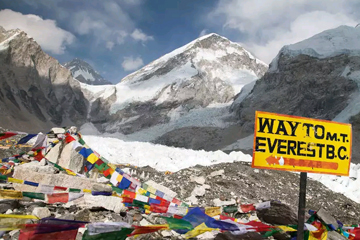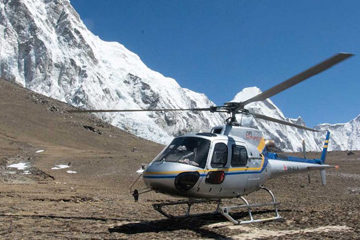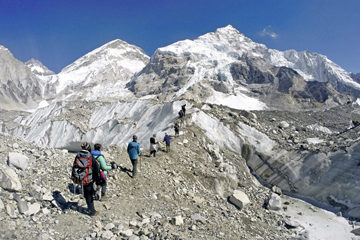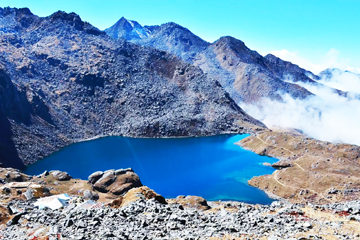14 days of Everest Base Camp Trek will take you to around 5400 m. The world famous treks gives you the ultimate views of many tall peaks over 8000 meters.
The trek is categorized as Moderate in terms of difficulty level. But Everest base Camp Trek for Beginner might be little challenging. The trek can be easily completed with basic physical fitness along with mental fitness. You will walk through the rocky trail with several uphill and downhill.
So is the Everest Base Camp trek worth it? Given the length of this trek (around 12 days), it’s more akin to a journey and one you can get your teeth into. Take the altitude seriously, be well equipped, be as fit as you can when you start, and importantly, be well organized. You will then enjoy this trek so much more.
TRIP HIGHLIGHTS
- Experience a dramatic Mountain flight with magical views of the Himalayas
- Spend 12 days acquainting yourself with the traditions and culture of the Sherpa people
- Cross high-altitude suspension bridges draped in colorful Buddhist prayer flags
- Climb to the viewpoint of Kala Patthar, where mountains like Everest, Lhotse, and Nuptse are close enough to touch
- Follow in the footsteps of world-renowned mountaineers to reach the base of the world’s tallest mountain
- Trek with a friendly and experienced local guide to learn more about the beautiful Khumbu region
The Everest Base Camp Trek is a spectacular high altitude trek in the mountains of Nepal. Prepare for jaw-dropping scenery and a unique cultural experience exploring the challenging trekking routes around the highest mountain in the world.
Everest Base Camp Trek is for nature lovers and the one who seeks to achieve a certain level of spirituality among themselves. This trek teaches people the true meaning of determination and patience.
Best Time For Everest Base Camp Trek
The best time for the Everest Base Camp trek typically falls during the pre-monsoon (spring) and post-monsoon (autumn/fall) seasons.
1.Spring Season (March to May):
-
- This period is characterized by mild temperatures and clear skies, making it an excellent time for trekking.
- The landscape blooms with rhododendrons and other wildflowers, adding color to the scenery.
- The temperatures are moderate, offering comfortable trekking conditions during the day with cool nights.
- Autumn/Fall Season (September to November):
- This is another popular time for the Everest Base Camp trek.
- The weather is generally stable with clear skies, providing excellent visibility of the surrounding mountains.
- Temperatures are pleasant during the day and cool at night, ideal for trekking.
- The trails are relatively dry, making trekking more comfortable compared to the monsoon season.
Both of these seasons offer stunning views of the Himalayas and are preferred by trekkers for their favorable weather conditions. It’s essential to consider factors like your personal preferences, level of experience, and availability when planning your trek to Everest Base Camp. Keep in mind that weather conditions can vary, so it’s always a good idea to check the latest weather forecasts and trekking conditions before embarking on your journey.
Notes For The Everest Base Camp Trek
- Physical Fitness: The trek to Everest Base Camp involves walking long distances at high altitudes. It’s essential to be in good physical condition and to prepare with cardiovascular exercises and hiking practice.
- Altitude Acclimatization: Acclimatization is crucial to avoid altitude sickness. Trekking itineraries should include rest days to allow your body to adjust to the increasing altitude. Drink plenty of water, avoid alcohol, and ascend gradually.
- Pack Light: Carry only essential items to reduce the weight of your backpack. Porters are available for hire to carry heavier loads if needed.
- Weather Conditions: Weather in the Himalayas can be unpredictable. Be prepared for sudden changes in weather, including cold temperatures, snowfall, and high winds. Bring appropriate clothing layers and gear for both sunny and cold conditions.
- Permits and Regulations: Obtain the necessary permits for trekking in the Sagarmatha National Park and the Everest region. Respect local customs, traditions, and environmental regulations during your trek.
- Guides and Porters: Consider hiring a local guide or porter for assistance and support during the trek. They are familiar with the terrain, can provide valuable information, and help with logistics.
- Accommodation and Food: Teahouses along the trekking route provide basic accommodation and meals. Be prepared for simple facilities, shared bathrooms, and limited food options. Carry snacks and water purification tablets if necessary.
- Health and Safety: Carry a basic first aid kit and any personal medications. Be aware of symptoms of altitude sickness and seek medical help if needed. Follow safety guidelines and avoid taking unnecessary risks during the trek.
- Responsible Trekking: Practice Leave No Trace principles by minimizing your environmental impact, disposing of waste properly, and respecting wildlife and local communities.
By keeping these important notes in mind and adequately preparing for your Everest Base Camp trek, you can enhance your experience and ensure a safe and enjoyable journey in the Himalayas.
Drink On The Everest Base Camp Trekking
During the Everest Base Camp trekking journey, it’s essential to stay hydrated to combat the effects of altitude and physical exertion. Here are some key points regarding hydration and beverages during the trek:
- Water: Drink plenty of water throughout the day to stay hydrated. Carry a reusable water bottle and use water purification tablets to treat water from taps or streams along the trail. Avoid drinking untreated tap water or water from unverified sources to prevent waterborne illnesses.
- Tea and Hot Beverages: Teahouses and lodges along the trekking route offer a variety of hot beverages such as tea, coffee, hot lemon, and hot juice. These can be comforting and help keep you warm, especially in cold weather. However, avoid excessive consumption of caffeinated beverages as they can contribute to dehydration.
- Avoid Alcohol and Smoking: Alcohol and smoking can exacerbate altitude sickness and dehydration. It’s advisable to refrain from drinking alcohol and smoking during the trek to minimize health risks and ensure a safer journey.
- Hydration Tips: Sip water frequently rather than gulping it down all at once. This helps your body absorb water more effectively and prevents overhydration. Pay attention to your urine color; clear or light yellow urine indicates proper hydration, while dark yellow urine may indicate dehydration.
- Altitude Sickness Awareness: Altitude sickness can occur at higher elevations, so it’s crucial to stay hydrated to mitigate its effects. Symptoms of altitude sickness include headache, nausea, dizziness, and fatigue. If you experience any of these symptoms, descend to a lower altitude and seek medical attention if necessary.
Essential Equipment and Gear:
- Clothing:
- Insulated jacket or down jacket
- Waterproof jacket and pants
- Trekking pants/shorts
- Moisture-wicking base layers
- Insulating layers (fleece jacket, thermal tops)
- Warm hat and gloves
- Hiking socks and sturdy hiking boots
- Equipment:
- Backpack (45-65 liters)
- Sleeping bag (rated for cold temperatures)
- Trekking poles
- Headlamp/flashlight with extra batteries
- Sunglasses with UV protection
- Sunscreen and lip balm
- Water bottles or hydration system
- Camera or smartphone for capturing memories
- Miscellaneous:
- First aid kit (including altitude sickness medication)
- Toiletries (toothbrush, toothpaste, biodegradable soap, hand sanitizer)
- Trekking towel
- Snacks and energy bars
- Cash (Nepalese Rupees) for purchasing items along the trail and tipping guides/porters
- Trekking permits and TIMS card
Tips:
- Acclimatization: Take your time to acclimatize properly to the altitude. Spend a few days at intermediate elevations like Namche Bazaar to allow your body to adjust.
- Stay Hydrated and Nourished: Drink plenty of water and eat regular, nutritious meals to maintain energy levels and avoid altitude sickness.
- Pack Light: Carry only essential items to minimize the weight on your back and make the trek more enjoyable.
- Follow Safety Guidelines: Listen to your guide’s advice and pay attention to weather conditions and trail conditions.
- Respect the Environment and Culture: Practice responsible trekking by disposing of waste properly and respecting local customs and traditions.
- Be Flexible: Weather conditions in the mountains can be unpredictable, so be prepared for changes to your itinerary.
The Everest Base Camp trek is a challenging but incredibly rewarding adventure that offers unforgettable views and experiences. With proper preparation and the right gear, you can make the most of this epic journey in the Himalayas.
Day 1: Arrival in Kathmandu
- Arrive at Tribhuvan International Airport.
- Transfer to your hotel in Kathmandu.
- Meet your trekking guide for a briefing.
- Explore Kathmandu city and prepare for the trek.
Day 2: Fly to Lukla, Trek to Phakding (2,652m)
- Take an early morning scenic flight to Lukla (2,800m).
- Begin trekking to Phakding, a small settlement along the Dudh Koshi River.
- Overnight stay in Phakding.
Day 3: Phakding to Namche Bazaar (3,440m)
- Trek along the Dudh Koshi River.
- Enter Sagarmatha National Park at Monjo.
- Cross several suspension bridges.
- Reach Namche Bazaar, the bustling Sherpa town and gateway to the Everest region.
- Overnight stay in Namche Bazaar.
Day 4: Acclimatization Day in Namche Bazaar
- Rest and acclimatize to the altitude.
- Optional hike to Everest View Hotel or Khumjung village.
- Explore Namche Bazaar’s markets, museums, and bakeries.
- Overnight stay in Namche Bazaar.
Day 5: Namche Bazaar to Tengboche (3,860m)
- Trek through forests with views of Everest and Ama Dablam.
- Descend to Phunki Tenga and cross a suspension bridge.
- Ascend to Tengboche, home to the famous Tengboche Monastery.
- Overnight stay in Tengboche.
Day 6: Tengboche to Dingboche (4,410m)
- Descend through rhododendron forests to Debuche.
- Cross the Imja River and ascend gradually to Pangboche.
- Continue trekking to Dingboche, with stunning views of Lhotse and Island Peak.
- Overnight stay in Dingboche.
Day 7: Acclimatization Day in Dingboche
- Rest and acclimatize in Dingboche.
- Optional hike to Nagarjun Hill or Chhukung Valley.
- Enjoy breathtaking views of the surrounding peaks.
- Overnight stay in Dingboche.
Day 8: Dingboche to Lobuche (4,910m)
- Trek along the moraine of the Khumbu Glacier.
- Pass through Dughla and ascend to Lobuche.
- Enjoy panoramic views of Nuptse, Pumori, and other peaks.
- Overnight stay in Lobuche.
Day 9: Lobuche to Gorak Shep (5,164m), Visit Everest Base Camp (5,364m)
- Trek to Gorak Shep, the last settlement before Everest Base Camp.
- Continue to Everest Base Camp, following the Khumbu Glacier.
- Spend some time at Base Camp, take photos, and soak in the atmosphere.
- Return to Gorak Shep for overnight stay.
Day 10: Hike to Kala Patthar (5,545m), Descend to Pheriche (4,371m)
- Early morning hike to Kala Patthar for sunrise views of Everest and surrounding peaks.
- Descend to Gorak Shep for breakfast.
- Continue trekking downhill to Pheriche.
- Overnight stay in Pheriche.
Day 11: Pheriche to Namche Bazaar
- Trek back to Namche Bazaar, retracing your steps.
- Enjoy the downhill trail and beautiful scenery.
- Overnight stay in Namche Bazaar.
Day 12: Namche Bazaar to Lukla
- Trek back to Lukla.
- Celebrate the completion of your trek with your guide and team.
- Overnight stay in Lukla.
Day 13: Fly back to Kathmandu
- Take an early morning flight back to Kathmandu.
- Rest and relax in Kathmandu.
- Explore the city, do some last-minute shopping, and enjoy a farewell dinner.
Day 14: Departure from Kathmandu
- Transfer to Tribhuvan International Airport for your departure flight
International and domestic pick up and drop off by private car/Jeep/ Hiace.
2 night hotel accommodation with breakfast (B/B) in Kathmandu
All necessary papers including Everest national park permit and TIMS card (Trekking Information Management System)
Meals on a full-board basis (Breakfast, Lunch, and Dinner/ the main course) during the trek in the mountain.
Nature View Trek’s experienced, government-licensed, English-speaking trekking guide.
All salary, food, drinks, accommodation, transport, and insurance for the guide.
Trekking equipment such as the Sleeping bag, and down jacket on request (optional)
Trekking lodges (Tea House) throughout the trek
Airfare from Kathmandu – Lukla – Kathmandu.
Seasonal fresh fruits are desert every evening after dinner.
Appreciation of certificate after the successful trek.
Farewell Dinner at a typical Nepalese restaurant with traditional music and dance
Oximeter to measure your oxygen and Pulse level during the trek in the mountain.
Compressive first aid box (Guide will carry it throughout the trek).
Emergency rescue operation assistance in arranging in case of complex health conditions (funded by your Travel Insurance)
All government, Local taxes/ vat, and official expenses
Nepal entry Visa fees
Lunch and Dinner while in Kathmandu(2 days)
Kathmandu Sightseeing Tour
Your Travel Insurance
International Airfare and Airport Tax
Your Travel Insurance
All Drinks.
Personal things like postage, a hot water, internet, and laundry
Tips for guide & porter










Tour Reviews
There are no reviews yet.
Leave a Review